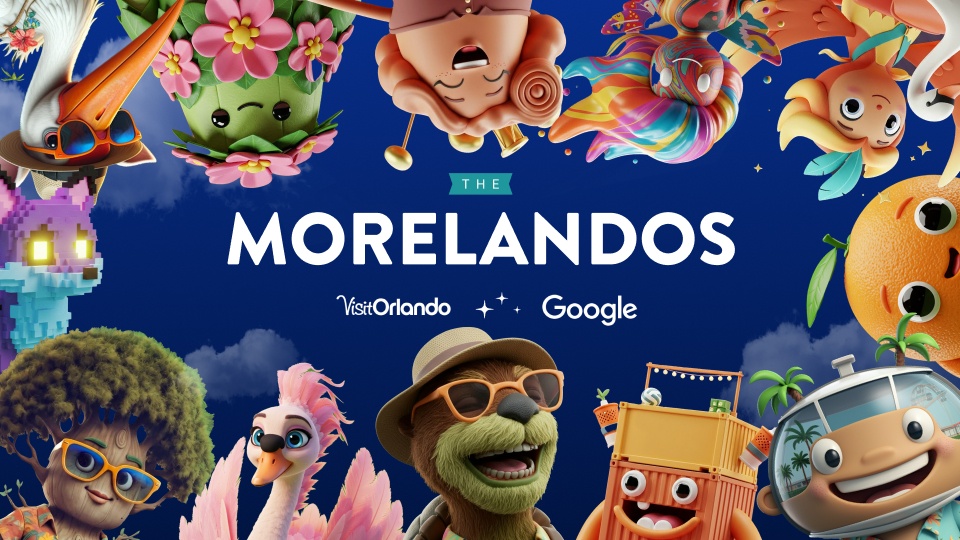Razorfish Uses Google AI Tools to Create a Cast of Characters Designed to Highlight Orlando's Hidden Gems
Meet The Morelandos
Millions of visitors flock to Orlando, Fla., each year, primarily drawn by the city’s iconic theme parks.
However, Orlando is a vibrant city rich with art, culture, nature-oriented attractions, diverse dining, and nightlife. To reveal a city of hidden gems beyond its famous theme parks, Visit Orlando teamed up with Razorfish to use Google AI for ambitious world-building. Leveraging a custom Vertex AI system, Gemini, Veo and Imagen, they transformed thousands of Google reviews into “The Morelandos”—a delightful cast of 1,200 unique characters representing local spots. This feat of world-building at a scale previously unthinkable provided detailed, character-driven recommendations for tourists.
For example, Splashton the otter loves the natural springs at Rock Springs in Kelly Park, while music-loving Acoustica praises Steinmetz Hall. Lookseedo, a fan of ICON Park, highlights its spectacular views. These are just a few of the Morelando characters serving as ambassadors for Orlando’s wide array of businesses and attractions.
Here, Anthony Yell, CCO at Razorfish, takes us behind-the-scenes of the campaign and explains how Google AI made this ambitious project possible:
MUSE: What was the benefit in using Gemini to mine Google reviews for Orlando attractions as opposed to having members of your team manually sort through posts?
Anthony Yell: Gemini gave us more than time savings—it gave us a creative starting point. We prompted it to mine thousands of public reviews and imagine: what kind of character could emerge from this place? What story would reflect how people experienced it? What kind of world would they live in? That output helped our team move faster and think wider. Instead of spending hours combing through data, they could jump straight into shaping, refining, and bringing those ideas to life.
That mix—what the AI surfaces and what a human builds from it—is what led to characters that actually feel original, dimensional and unbelievably real.

Can you take us through the process of creating these characters via Gemini and Imagen?
We built a multi-step workflow across Gemini, Imagen and Veo—using prompt engineering to move from insight to narrative to expression.
With Gemini, we prompted the model to analyze thousands of reviews per location—not just for keywords, but for emotion, point of view and storytelling cues. From that, we generated character themes and early narrative ideas: who might this character be, what kind of world do they live in and what’s their role in it?
Once we had a strong foundation, we used Imagen to visualize them—prompting for personality traits, style and environmental detail to match the story. Imagen gave us consistency, nuance and fidelity.
Then Veo brought them into motion, generating scenes that matched each character’s emotional arc.
We moved between tools with creative intent, treating the system like a connected pipeline—not a set of one-off prompts. That’s why the characters feel like they belong together and feel real.
Once the characters and narratives were locked, we brought them to life using Imagen—creating distinctive, dimensional personalities tied to real places across Orlando.
From there, they became active participants in the campaign. They show up in Google Maps to guide discovery, in Veo 2–generated ads that make the invitation feel personal, and in AR—so people can find and interact with them in the real world. They live across Visit Orlando’s ecosystem and beyond—with room to grow into social, interactive content and future experiences. Each one opens a door to a different side of the city.

Why are the Morelandos such valuable assets?
Because they’re more than campaign elements—they’re story engines. Each character is rooted in real visitor experiences, giving them instant authenticity. But from there, they become ownable IP—a creative layer we can extend, evolve and build narratives around, just like the world’s most beloved brands do. They bring personality to places people might otherwise overlook, and they give us a flexible storytelling framework we can grow over time—across media, platforms and even merch. It’s not just about where they live in Orlando—it’s about where they can go next.
What was the biggest challenge in creating this campaign? What did you have to make sure you got right for this effort to succeed?
Consistency across the entire workflow. From the original reviews to the final character expressions, everything had to align. The tone of the data, the arc of the story, the style of the visuals—it all needed to feel part of the same world.
We weren’t creating one character in isolation. We were building a full cast—each with their own voice, but all living under the Unbelievably Real idea. That meant refining prompts, testing outputs, and calibrating how the tools—Gemini, Imagen, Veo—handed off to one another.
That level of creative consistency across tools, formats and characters was the hardest part—and the most critical to get right.
What did you learn about AI while working on this project?
We often treat AI tools as individual tasks—one for writing, one for visuals, one for video. This was a chance to zoom out and build a true creative workflow—stitching together Gemini, Imagen, and Veo so each tool handed off cleanly to the next, with one shared creative intent.
It also reminded us how fast this space is evolving. What we built was based on the tools available then—not the ones launching next week. That’s what’s so exciting. With the right workflow and a clear vision, we can keep pushing boundaries—making the impossible ad possible, and doing it faster, smarter and more creatively than ever before.



 Events
Events


